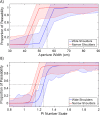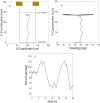Sensory substitution: The affordance of passability, body-scaled perception, and exploratory movements
- PMID: 30917133
- PMCID: PMC6436680
- DOI: 10.1371/journal.pone.0213342
Sensory substitution: The affordance of passability, body-scaled perception, and exploratory movements
Abstract
The theory of affordances states that perception is of environmental properties that are relevant to action-capabilities of perceivers. The present study illustrates how concepts and methodological tools from the theory of affordances may help to advance research in the field of sensory substitution. The sensory substitution device (SSD) that was used consisted of two horizontal rows of 12 coin motors that each vibrated as a function of the distance to the nearest object. Sixty blindfolded participants used the SSD to explore virtual horizontal apertures with different widths. They were asked to judge the passability of the apertures. Participants with narrow shoulders judged narrower apertures as passable than participants with wide shoulders. This difference disappeared when aperture width was scaled to shoulder width, demonstrating that perception was body scaled. The actual aperture width was closely related to aspects of the exploratory movements and to aspects of the vibrotactile stimulation that was obtained with the exploratory movements. This implies that the exploratory movements themselves and the vibrotactile stimulation were both informative about the aperture width, and hence that the perception of passability may have been based on either of them or on a global variable that spans vibrotactile as well as kinaesthetic stimulation. Similar performance was observed for participants who accomplished the 7-trial familiarization phase with or without vision, meaning that practice with vision is not indispensable to learn to use the SSD.
Conflict of interest statement
The authors have declared that no competing interests exist.
Figures






References
-
- Craig JC (1976). Vibrotactile letter recognition: The effects of a masking stimulus. Perception & Psychophysics, 20, 317–326. 10.3758/BF03199412 - DOI
-
- Geldard FA (1966). Cutaneous coding of optical signals: The optohapt. Attention, Perception, & Psychophysics, 1, 377–381. 10.3758/BF03215810 - DOI
-
- Linvill JG, Bliss JC (1966). A direct translation reading aid for the blind. Proceedings of the IEEE, 54, 40–51. 10.1109/PROC.1966.4572 - DOI
-
- Dakopoulos D, Bourbakis NG (2010). Wearable obstacle avoidance electronic travel aids for blind: A survey. IEEE Transactions on Systems, Man, and Cybernetics, Part C: Applications and Reviews, 40, 25–35. 10.1109/tsmcc.2009.2021255 - DOI
Publication types
MeSH terms
LinkOut - more resources
Full Text Sources

